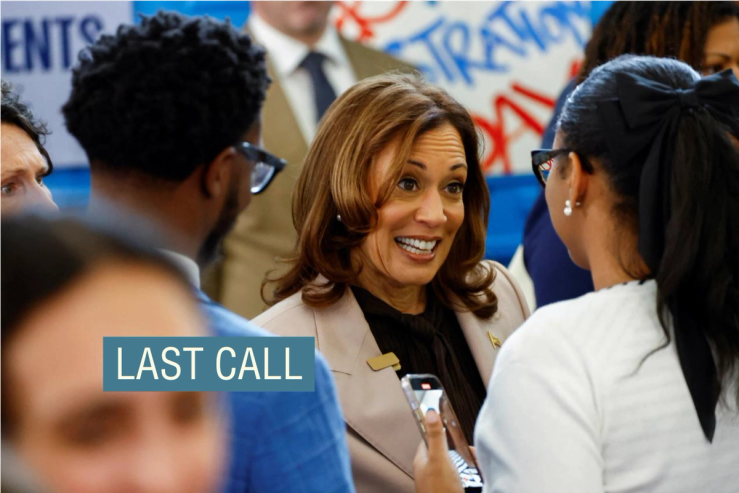The News
Here’s the most important thing to know about the closing message from the two campaigns: It’s not for you.
By that I mean you, the news junkie currently reading this who likely made their mind up on this election before it ever started and is near-certain to cast a vote. No, at this point the campaigns are targeting a much narrower group of voters — even by recent standards — who they see as more persuadable. And this explains a lot of their behavior in the final stretch.
In this article:
Benjy’s view
Political strategists sometimes stop to remind their fellow partisans that the median voter is a middle-class suburbanite in her 50s. But in a highly polarized country where turnout has rocketed to century-high levels in recent elections, it’s the increasingly rare marginal voter that can matter the most to the campaigns.
David Plouffe, the Harris campaign advisor, recently estimated on Pod Save America that the pool of “true” undecided voters stood at 4%, with a somewhat larger universe of “soft” supporters for either candidate. While the campaigns have fairly broad messages on issues like immigration and the economy and abortion that they expect to translate for wide audiences, they’ve also made big moves to reach increasingly smaller slices of voters, who may be a rounding error as part of American society writ large, but whose indecision makes them worth their time.
The Trump campaign, in particular, has been obsessed with so-called “low-propensity voters” along with voters who are distrustful of traditional politics and more likely to go third party. They devoted considerable time and energy to courting Robert F. Kennedy, Jr. ahead of his endorsement, and then on pitching his wellness-minded voters on a “Make America Healthy Again” message that belied most of Donald Trump’s actual record on the environment and nutrition. Before that, Trump spoke to the Libertarian Party — which barely registers in polls this cycle — in the hopes of consolidating the anti-government outsider vote. He’s also been aggressively trying to win over young men of all races, a historically unreliable voting cohort, with appearances on podcasts and YouTube shows in the “manosphere.” Harris, looking to counter this appeal, is reportedly negotiating an appearance on Joe Rogan’s podcast, the undisputed king of the format.
Speaking of those men: Former president Barack Obama was pilloried by some of his fellow Democrats recently for challenging Black men to ask themselves whether sexism explained their reluctance to vote for Vice President Kamala Harris. But Obama’s not out there trying to reach the median Black voter, he’s talking to a slice of a slice of a slice of voters that data, focus groups, and anecdotal evidence suggest to Democrats are on the fence. Defending traditional gender roles has been a major theme of Republican ads and speeches and our own reporting at pro-Trump events aimed at Black men even when Biden was still running turned up some quotes fretting about a more feminine and LGBTQ-inclusive society. That doesn’t mean Obama’s comments were appropriate or effective, just that it’s easier to understand why he’s doing it with a marginal voter frame in mind.
And if you really want to get into the niche vote, Harris’ own “opportunity agenda” for Black men that she debuted on Monday included protecting cryptocurrency as a plank. The campaign cited data suggesting 20% of Black Americans have owned digital assets at one point. That’s good enough for a bullet point in a policy rollout.
Turning to another key group, Harris has made winning moderate Republicans a top priority in the closing stretch, relying heavily on endorsements from former Trump supporters and promising a Republican cabinet member and bipartisan advisory team. This has drawn some pushback from critics on the left, who argue figures like the Cheneys are unpopular overall and that the number of conflicted Republicans or Republican-leaning independents left at this point in the Trump era are miniscule. But miniscule can matter in this environment: Democrats clearly see some of the same polling data that others do that shows, for example, a small slice of gettable Nikki Haley voters. In Arizona, where Harris is running ads featuring the Republican mayor of Mesa, Democrats have won multiple close races since 2018 by embracing John McCain’s legacy and accusing their opponents of abandoning it.
Both campaigns have put more time into winning over content creators outside of traditional media than prior campaigns. In addition to Trump’s various appearances with Theo Von, Logan Paul, and Elon Musk, Harris did lengthy interviews on the Call Her Daddy and All The Smoke Podcasts. This would be smart politics regardless — that’s where voters are these days — but it also reflects the importance of finding potential supporters who might be disengaged from the election. In a race to persuade and turn out that last maybe-voter who has never caught a minute of 60 Minutes, it makes sense for campaigns to actively prioritize hosts whose audiences are less political.
The All The Smoke episode with Harris, for example, included substantive discussions of racial justice, helping at-risk youth, and drug policy. But it also included another telling moment: At one point, the hosts asked her to explain to basketball-oriented listeners who might not follow politics how a bill becomes a law. In an election as tight as this one, those voters could be as decisive as any other.
Notable
- In Time, Yale’s Jeffrey Sonnenfeld and Stephen Henriques argue even the already-low number of genuine “undecided” voters in polls is historically exaggerated. Instead, they argue campaigns should prioritize turning out their base and identifying some potential late swing voters who back one candidate, but are open to reconsider their choice.
- Nate Silver praises both Trump and Harris for targeting marginal voters with unconventional media appearances and events. “Harris needs a majority of voters and — I think I can say this as a Weird American myself — weird voters are in the majority,” he writes.


